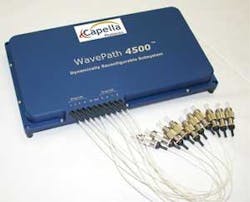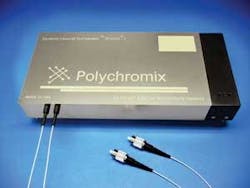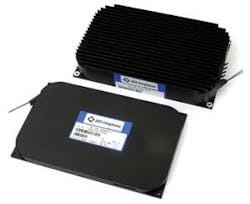ROADM subsystem choices abound
The reconfigurable optical-add/drop-multiplexer (ROADM)-subsystem market has seen a flurry of recent activity as vendors try to determine which architecture or technology best fits what application. To date, the only certainty is that there is no one-size-fits-all approach.
ROADM-subsystem designs vary from an advanced module with a high level of functional integration and embedded control all the way up to a full circuit pack or in some cases a collection of circuit packs. Devices typically referred to as “ROADM subsystems” often include advanced modules like wavelength blockers (WBs), which fall into the category of so-called fixed ROADMs because they are marginally tunable and can drop a predetermined number of wavelengths.
WBs are the most widely deployed ROADM subsystems to date. Last year saw the deployment of some 300-500 blockers, reports Mouli Ramani, vice president of marketing and business development at Polychromix (Wilmington, MA). The industry has accepted the WB as a viable option to provide ROADM functionality. RFPs from AT&T and MCI helped drive its acceptance in long-haul, and RFPs are beginning to surface in the metro as well, he says.That said, there are some industry insiders who believe the blocker popularity may have peaked. Ken Falta, vice president of sales at Capella Photonics (San Jose, CA), reports seeing a push toward the more flexible, fully tunable wavelength-selective switches (WSSs). “The wavelength blockers made a pretty big splash,” he notes, “but it looks like there’s a relatively short window of opportunity for them. I think that’s evident in the fact that most of the blocker companies have also developed programs for the wavelength-selective switches. I’d say a good many of our customers are looking at us to displace the blocker solutions.”
For his part, Barrie Keyworth, director of technology for subsystem products at JDS Uniphase (San Jose), does not see the WBs going away. “They are fairly well entrenched,” he says, though he admits that blockers have their share of limitations. “You need to have other devices around the blocker, so now the trend is to have more functionality integrated into a single block or a single subsystem. And those newer technologies will provide additional functionality and fit into other parts of the network.”
In keeping with this trend, San Jose-based NeoPhotonics has built its blockers and WSSs using planar-lightwave-circuit (PLC) technology in which the devices are implemented entirely in silicon. This manufacturing process enables a higher level of integration, which leads to higher performance, increased scalability, and a lower overall cost, explains NeoPhotonics marketing vice president Ferris Lipscomb.
“The advantage of integration is that once you’ve made something on a chip, adding a second function on that chip really doesn’t cost that much more,” says Lipscomb. “And it doesn’t really affect the performance very much. For example, if we combine a VOA with an AWG on one chip, adding that VOA adds only one- to two-tenths of excess loss. Whereas if that VOA was separate, it would have to be pigtailed separately, connected with fiber, and it would add a dB of extra loss.”
PLC technology is particularly well suited for the metro, reports Keyworth, because “it handles 100 GHz quite well. At 50 GHz, the channel counts are high and the channel flatness requirements go up, and that tends to be met by the free-space technology, the wavelength blockers, and the wavelength-selective switches.”
Like NeoPhotonics, JDS Uniphase also has a PLC ROADM. While its liquid-crystal-based WBs have seen better success in the long-haul market, the company reports its PLC ROADM is making inroads in the metro space.
But most of the development activity today appears to be centered on WSSs, which are far more flexible than blockers and PLC subsystems, capable of any-wavelength-any-drop functionality. Both Capella Photonics and Stockholm-based Metconnex have demonstrated WSSs; Polychromix is set to unveil one at this month’s OFC/NFOEC in Anaheim; and JDSU and NeoPhotonics have devices under development.
Capella’s WavePath family of WSSs employs a combination of diffractive gratings and MEMS mirrors to enable a compact device that integrates seven typically discrete functions. “There is nothing else you need to put in the node other than the control of our module,” contends Falta. The company claims it has over a half-dozen customers already, including system vendor Meriton Networks (Ottawa, Ontario), and has received evaluation requests from two dozen others.Metconnex, meanwhile, unveiled its WWS 5400 wavelength-selective switch at ECOC last September. Designed for the metro and regional ROADM market, Metconnex’s device features a hybrid integration of waveguides and MEMS. Like the Capella device, the 5400 also integrates several critical functions, including multiplexing, demultiplexing, hitless switching, wavelength blocking, and attenuation.
Right now, the big hurdle for the WSS is its cost, which is still a bit high for the price-sensitive metro and access markets. “The debate going on in the industry right now is how much flexibility and how much functionality at what cost,” observes NeoPhotonics’ Lipscomb. “Everyone would like the full wavelength-selective switch where you could drop any wavelength to any fiber or any number of wavelengths to any fiber, but it costs more. I think the industry is still working out what the cost versus functionality benefit is going to be.”
Polychromix says it has a handle on that problem, claiming its new WSS could be even less expensive than a WB. The company’s WBs are based on diffractive MEMS, but its new switch employs mirror-based MEMS to enable it to more efficiently address higher-port-count applications. The device has already found a lead customer, which Polychromix will announce at OFC.Just how do vendors decide, among all the various combinations of technologies and architectures, which are the most appropriate for a particular application? According to Keyworth, the choice is often linked to other decisions that have been made regarding the network architecture.
What is the maximum capacity of your network? Are you planning for 50 GHz and a very high wavelength count? Such choices will likely lead you to a particular technology. Are you looking for a higher percentage drop but a lower wavelength count? That might lead you to adopt another technology, says Keyworth. If you are doing upgrades in the future to ring-to-ring interconnect, what is your strategy? Are you going to use optical-electrical-optical (OEO) technology, or will you do it all-optically? If you’re going to do it all-optically, do you want to have one type of ROADM subsystem or module or do you want to have two types, one for the add/drop and one for the ring-to-ring interconnect?
“These types of choices-each one unique to each system vendor-lead you to a different technology choice,” says Keyworth. “There isn’t really a one-size-fits-all scenario.”
A spate of carrier RFPs have led to a flurry of development activity, but how much is real and how much is merely hype? “What people are attempting to say now is that you put the ROADM in and you try to scale it,” says Lawrence Gasman, president of market researcher CIR (Charlottesville, VA). “As WDM builds up and channels build up, you really are going to need some kind of crossconnect application. It’s very typical of service providers to stick something in and gradually upgrade it until it becomes something else, so I think that’s a reasonable strategy,” he says. “The big question is, how many years? It could be quite a long time.”
All the vendors interviewed here are slightly more bullish, believing the market will heat up in the late 2005/2006 time frame. They also expect this month’s OFC to be as ROADM-centric as last year’s event. Last year, vendors debuted their concepts; this year, “the proof is in the pudding,” says Polychromix’s Ramani. “People are going to say, ‘Let’s see those devices now and how they operate.’ ”Meghan Fuller is the senior news editor at Lightwave.




